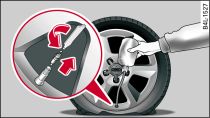
- Fig. 1 Repairing a tyre
Applies to vehicles: with tyre repair kit
Preparations
If you have a flat tyre, stop the car well away from moving traffic.
Apply the parking brake to stop the vehicle moving accidentally.
Move the selector lever to position P.
Check whether a repair is possible using the tyre repair kit Link.
Ensure that all passengers leave the vehicle and move away from the danger area WARNING!.
Take the tyre sealant can and the compressor out of the luggage compartment.
Fix the sticker "max. 80 km/h", which is included with the tyre sealant can, onto the instrument cluster where the driver will see it.
Filling the tyre
Shake the tyre sealant can well.
Screw the enclosed filling hose onto the sealant can as far as it will go. This will automatically pierce the foil sealing the can.
Take the valve cap off the tyre valve and use the enclosed valve insert tool to unscrew the valve insert Fig. 1.
Place the valve insert onto a clean surface.
Remove the sealing plug from the filling hose and insert the hose into the tyre valve.
Hold the tyre sealant can upside down and fill the complete contents of the can into the tyre.
Then disconnect the hose and screw the valve insert firmly back into the tyre valve.
Inflating the tyre
Screw the compressor filler hose onto the tyre valve.
Plug the connector of the compressor into one of the vehicle's sockets Link.
Pump the tyre up to 2.5 to 3.5 bar and monitor the pressure shown on the pressure gauge.
If the tyre pressure remains lower than the value specified above drive the vehicle approx. 10 metres forwards or backwards, so that the sealant can spread evenly in the tyre. If the pressure is still lower than the specification the tyre is too badly damaged and cannot be repaired using the tyre sealant.
Final checks
After about 10 minutes stop to check the tyre pressure.
If tyre pressure is less than 1.8 bar, the tyre is too badly damaged. Do not drive on. You should obtain professional assistance.
- If you have a puncture in moving traffic, switch on the hazard warning lights and place the warning triangle in a visible location. This is for your own safety and also warns other road users.
- Make sure your passengers wait in a safe place (for instance behind the roadside crash barrier).
- Please observe the manufacturers' safety notes on the compressor and the instructions supplied with the tyre sealant can.
- If it was not possible to build up a tyre pressure of 2.5 bar within 12 minutes, this means that the tyre is too badly damaged. Do not drive on.
- Seek professional assistance if the repair of a tyre puncture is not possible with the sealing compound.
- If tyre pressure is less than 1.8 bar after driving about 10 minutes, the tyre is too badly damaged. Do not drive on. You should obtain professional assistance.
Caution!
Take special care if you have to repair a tyre on a gradient.
Note
- Do not use the compressor for longer than 12 minutes at a time, as it could overheat. When the compressor has cooled down, you can use it again.
- Do not connect the compressor to the cigarette lighter socket as it will not provide the necessary power level.
- If tyre sealant should leak out, leave it to dry and then pull it off like foil.
- After carrying out a tyre repair remember to buy a new tyre sealant can at a qualified workshop. This will ensure that the tyre repair kit is operative again.
- Please observe the relevant regulations.
